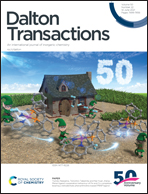Mixed functionalization strategy on indium-organic framework for multiple ion detection and H2O2 turn-on sensing†
Abstract
A special functional group mediated functionalization platform is introduced as a new and versatile platform tool to improve the fluorescence detection performance of metal–organic frameworks (MOF). The creation of a mixed-functionalization strategy on a MOF realizes the high sensitivity detection of heavy metal ions, anions and small molecules. In this work, we have first reported a novel amino functionalized 3D indium MOF [In(BDC-NH2)(OH)]n (In1-NH2) which not only has an excellent fluorescent characteristic but also shows highly sensitive identification of Fe3+, Cu2+, Pb2+ and ClO− in water with broad linear ranges and short response times. Subsequently, based on the remaining amino group site of In1-NH2, a post-synthetic modification strategy is utilized to introduce an active boronic acid group for hydrogen peroxide detection. The obtained PBA-In1 exhibits an efficient sensing performance for hydrogen peroxide with an LOD of 0.42 μM. Given this, PBA-In1 is expected to become an effective probe to monitor the formation of metabolites in humans. In1-NH2 successfully achieves multiple ion detection and the PBA-In1 sensing platform with boronic acid functionalization may have good application prospects in biochemical research in the future.



 Please wait while we load your content...
Please wait while we load your content...